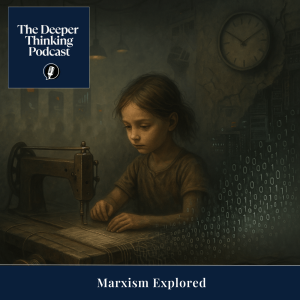
Thursday Mar 20, 2025
Marxism Explored - The Deeper Thinking Podcast
History does not move forward; it repeats in disguise. A child in a factory does not dream of revolution. There is no dialectic in her breathless counting of stitches, only the discipline of repetition and the hunger that waits outside the gate. And yet, within this precise monotony, something accumulates—an invisible sediment of unrest. Systems that insist on invisibility breed the impulse to be seen. The machine hums, the clock insists, and still, in the slippage between shifts, a murmur rises. It is not language yet, not theory. But it is the raw material of both.
There is a phrase in German—Stimmung—that carries no perfect English equivalent. It is not mood, not atmosphere, but the felt tone of a world. Marx moved through this Stimmung of upheaval, where steam and soot obscured the future and made the present unbearably legible. He read Hegel backwards and labor forward, imagining a consciousness forged not in thought but in motion, in production, in the shape of hands and the calluses they collect. What he extracted was not prophecy, but pattern. And patterns, once named, do not disappear. They echo. Then mutate.
"There is another world, but it is in this one." — Paul Éluard
The bourgeoisie, he wrote, “has pitilessly torn asunder the motley feudal ties.” But the new ties are thinner and more elastic. Algorithms now do what overseers once did, only faster and with better interfaces. The worker logs in, swipes, delivers, refreshes. No smokestack. No whistle. Just notifications. The factory has been dismembered and scattered into pockets, dashboards, gig portals. Still, the wage remains. Still, the surplus flows. Still, the contradiction holds: the many build the world they do not own.
Revolutions do not begin with books. They begin with shortages, with lines, with quiet realizations that nothing is changing except the price of bread. But revolutions, too, betray their origins. Theories fracture when they meet the mess of implementation. Lenin’s steel replaced Marx’s ink. Mao’s marches ground dialectics into dust. In seeking to abolish exploitation, they institutionalized it in new uniforms. History did not end, it turned in on itself. The anchor image returned—factories, fists, red banners—but not unchanged. Blood dimmed the theory. The utopia metastasized.
So it is. Labor without location, protest without cohesion, identity without coalition. The digital sphere promises global solidarity, but delivers fragments: hashtags instead of unions, avatars instead of organizers. Is this the new proletariat—dispersed, digitized, and dopaminergic? Or is this the final adaptation of capital, absorbing resistance by aestheticizing it, selling Che Guevara on t-shirts while mining cobalt for smartphones that post the revolution in real-time?
Then, a disruption. A figure stands not in a square, but alone, in front of a screen. The algorithm has predicted their rage. The advertisement has tailored their dissent. The marketplace has monetized their isolation. And yet— Something doesn’t compute.
Historical materialism insists that the base determines the superstructure, but in the era of virtual markets and synthetic labor, where exactly is the base? The cloud has no chimney. The factory has no gate. The worker has no shift, only a stream. But even in this soft architecture, the hard edges persist: eviction, extraction, exhaustion. The contradictions have gone translucent. That does not make them less sharp.
The child in the factory still counts. The object of her labor changes, the interface changes, but the logic holds. She does not name the system. She does not quote theory. But the murmur remains, and in the murmur, an outline—a form not yet formed, a tension not yet resolved. It waits.
No comments yet. Be the first to say something!